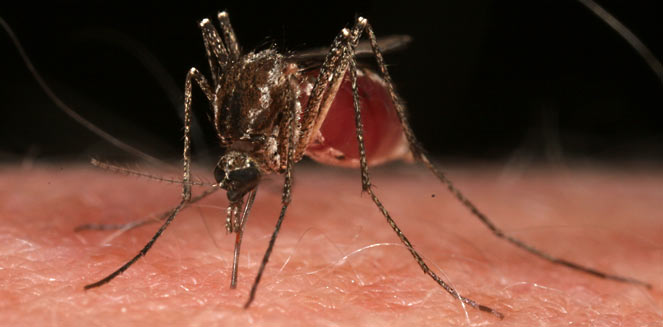|
Family: Culicidae (mosquitoes)
Life
> Eukaryotes >
Opisthokonta >
Metazoa (animals) > Bilateria > Ecdysozoa
> Panarthropoda > Tritocerebra > Phylum:
Arthopoda > Mandibulata >
Atelocerata > Panhexapoda >
Hexapoda
> Insecta (insects) > Dicondyla > Pterygota >
Metapterygota > Neoptera > Eumetabola > Holometabola > Panorpida > Antliophora
> Diptera (flies) > Culicomorpha
 |
|
Mosquito sucking blood from brave photographer in
Cape Town garden. [photo H. Robertson, Iziko
©] |
Mosquitoes breed in stagnant water. The female mosquito requires a blood meal in order to have enough protein to lay eggs. Mosquitoes can carry various diseases, the most virulent in Africa being malaria which kills over 1.5 million people in Africa annually, most of them children. Fortunately, malaria does not occur in the Western Cape but nevertheless mosquitoes can be very troublesome and cause nights of bad sleep.
The following procedures are useful for preventing bites by mosquitoes:
- use repellents on the skin such as Tabard - a mosquito will bite any exposed area that has no repellent on it so a dab here and there is not good enough;
- if you are out in the open at night, e.g. round camp fire, dress to avoid being bitten, e.g. by wearing long pants. In malaria areas, it might even be worth treating the clothes with insecticides such as Peripell (active ingredient
permethrin);
- put gauze over windows that are opened at night;
- use a bed net over your bed. These can be purchased from camping shops. Bed nets are much more effective if they are treated with an insecticide such as Peripell or Solfac (active ingredient
cyfluthrin); and
- kill mosquitoes in a room using mosquito coils, heated pyrethroid insecticide mats or a low-toxicity aerosol insecticide. Be careful not to overuse such products, as even the least harmful ones might affect you in unexpected ways.
If you are entering malaria areas, it is vital that you go out of your way to prevent being bitten and in addition take prophylactic drugs (consult your doctor on the right ones to take).
In the month following a visit to a malaria area, take any flu-like symptoms (temperature, sore muscles)
extremely seriously and insist on being tested for malaria even if your doctor does not think it is malaria. Doctors that work in non-malaria areas can be very ignorant about this life-threatening disease.
Classification
- Subfamily: Anophelinae
(40 species in
southern Africa). The identification of members of this subfamily in Africa
has been dealt with by Gillies & De Meillon (1968) and Gillies &
Coetzee (1987).
- Genus: Anopheles. Transmit
the parasite Plasmodium which causes malaria.
- Subfamily: Culicinae
(174 species in
southern Africa). For identification and basic biology of these
mosquitoes, see Jupp (1996). Genera occurring in southern Africa:
- Genus: Aedeomyia
- Genus: Aedes. Species of Aedes
are major vectors of viral diseases including Chikungunya and
Dengue.
- Genus: Coquillettidia
- Genus: Culex. Some species
are important vectors of the diseases including West Nile and Rift
Valley Fever.
- Genus: Culiseta
- Genus: Eretmapodites
- Genus: Ficalbia
- Genus: Malaya
- Genus: Mansonia
- Genus: Mimomyia
- Genus: Uranotaenia
- Subfamily: Toxorhynchitinae
Publications
Biology
Systematics
-
Gillies, M.T. & De Meillon, B. 1968. The
Anophelinae of Africa south of the Sahara (Ethiopian zoogeographical
region), 2nd edition. South African Institute for Medical Research,
Johannesburg (Publ. 54: 1-343).
-
Gillies, M.T. & Coetzee, M. 1987. A
supplement to the Anophelinae of Africa south of the Sahara (Afrotropical
Region). South African Institute for Medical Research, Johannesburg
(Publ. 55: 1-139).
-
Jupp, P.G. 1996. Mosquitoes of Southern
Africa - Culicinae and Toxorhynchitinae. Ekogilde Publishers, P.O. Box
178, Hartebeespoort 0216, South Africa.
Links
|
